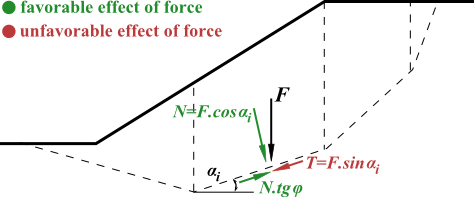Slope Stability Analysis
Analysis based on EN 1997 introduces several partial factors according to the selected Design approach (DA).
Designing a structure according to EN 1997-1 essentially follows the analysis of limit states.
Load reduction (DA1, DA2, DA3):
Loads acting on a strip are reduced in the analysis by partial factors. Depending on the inclination of the slip surface, the program evaluates whether the gravity force acting on a given block is favorable or not. If the favorable action of the force is greater than the unfavorable one, the program adopts the favorable coefficient. Based on that, the weight of block W is multiplied by the partial factor for the permanent load.
The water load is reduced by the partial factor, which multiplies the resulting pore pressure and forces due to unconfined water above the terrain.
 Determining whether the force action is favorable or not
Determining whether the force action is favorable or not
For input surcharges, the program first evaluates whether these act favorably or not, and then multiplies the overall load by the corresponding partial factor.
Reduction of material (DA1, DA3):
Parameters of soils are automatically reduced by the corresponding partial factors.
Reduction of resistance (DA2):
Resistance on a slip surface is reduced.
WARNING !!! | When calculating slope stability based on total parameters, DA2 and DA1 (comb. 1) give unrealistic results caused by a different reduction of the self-weight of massive (favorable and unfavorable). If adopting these approaches we recommend adjusting the partial factors manually (i.e. to increase the reduction partial factor on the resistance on the slip surface and to decrease reduction partial factors on load actions). |